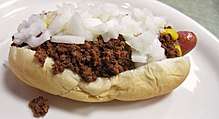Coney Island hot dog
A Coney Island hot dog (or Coney dog or Coney) is a hot dog in a bun topped with a savory meat sauce and sometimes other toppings. It is often offered as part of a menu of classic American "diner" dishes and often at Coney Island restaurants. It is largely a phenomenon related to immigration from Greece and Macedonia to the United States in the early 20th century.
 A Coney dog | |
| Course | Main course |
|---|---|
| Place of origin | United States |
| Serving temperature | Hot |
| Main ingredients | Hot dog, or a beef or beef and pork European-style Vienna sausage with lamb or sheep casing, topped with a meat sauce made of seasoned ground beef or beef heart, topped with yellow mustard, white onion and sometimes cheese. |
Origin
"Virtually all"[1]:233 Coney Island variations were developed, apparently independently, by Greek or Macedonian immigrants in the early 1900s, many fleeing the Balkan Wars, who entered the US through Ellis Island in New York City. Family stories of the development of the dishes often included anecdotes about visits to Coney Island.[2]
The first documented European name for the island is the Dutch name Conyne Eylandt[3] or Conynge Eylandt. This would roughly be equivalent to Konijn Eiland using modern Dutch spelling, meaning Rabbit Island.[4][5] The name was anglicized to Coney Island after the English took over the colony in 1664,[6] coney being the corresponding English word. The hot dog's fame later spread from this part of Brooklyn, New York, where Nathan Handwerker, a Polish/Jewish immigrant was one of the first entrepreneurs who sold them on the Coney Island boardwalk. His business was later named "Nathan's," an iconic brand that remains popular as both a fast-food chain and as a grocery product. The alternate name for a hot dog - a "Coney," most likely derived from the positive regional and national publicity Nathan's began to generate.
Regional and local varieties
Indiana

Ft. Wayne's Famous Coney Island Wiener Stand was opened in 1914 by three now-unknown Macedonian immigrants. Vasil Eschoff, another Macedonian immigrant, purchased an interest from one of the original owners in 1916. Eschoff's descendants have operated the restaurant since.[7] The Coney Island in Fort Wayne is described as a small, fatty pink hot dog with a "peppery-sweet" coney sauce on a soft bun.[1]:234 However, the ground beef-based coney sauce at Ft. Wayne's Famous Coney Island Wiener Stand has the flavor and consistency of a mild peppered savory pork sausage, reflecting its Macedonian heritage. The small hot dog is grilled on a flattop, placed in a steamed bun, yellow mustard applied, then a few teaspoonfuls of the savory chili sauce are added which is then topped with chopped yellow onion.
Michigan
Jane and Michael Stern, writing in 500 Things to Eat Before it's Too Late, note that "there's only one place to start [to pinpoint the top Coney Islands], and that is Detroit. Nowhere is the passion for them more intense."[1]:233 James Schmidt, in a debate at the 2018 National Fair Food Summit, noted that "Detroit is synonymous with the Coney Dog: you simply cannot have one without the other." [8]:233
The Coney Island developed in Michigan is a natural-casing beef or beef and pork European-style Wiener Würstchen (Vienna sausage) of German origin, topped with a beef heart-based sauce, one or two stripes of yellow mustard and diced or chopped onions. The variety is a fixture in Flint,[9] Detroit, Jackson, Kalamazoo, and southeastern Michigan.[10] The style originated in the early 20th century, with competing claims from American and Lafayette Coney Islands (1917)[11] in Detroit, and Todoroff's Original Coney Island (1914) in Jackson.[10] The longest continuously operated Coney Island (in the same location) is in Kalamazoo (1915).[12]
Detroit style
In Detroit, historically many Greek and Macedonian immigrants operated Coney islands, or restaurants serving Detroit Coney dogs. By 2012 many Albanians began operating them as well.[13] The Greeks established Onassis Coney Island, which has closed. Greek immigrants established the Coney chains Kerby's Koney Island, Leo's Coney Island, and National Coney Island during the 1960s and early 1970s. All three chains sell some Greek food items with Coney dogs. Detroit style sauce is a bean-less chili sauce, differing from the chili dogs they offer only in the lack of beans. National has most of its restaurants on the east side of the city, and Kerby's and Leo's have the bulk of their restaurants on the west side of the Detroit area.[14]
Flint style

Flint style is characterized by a dry hot dog topping made with a base of ground beef heart, which is ground to a consistency of fine-ground beef.[15] Some assert that in order to be an "authentic" Flint coney, the hot dog must be a Koegel coney and the sauce by Angelo's, which opened in 1949.[9][16] However, the sauce was originally developed by a Macedonian in 1924, Simion P. (Sam) Brayan, for his Flint's Original Coney Island restaurant. Brayan was the one who contracted with Koegel Meat Company to make the coney they still make today, also contracting with Abbott's Meat to provide the fine-grind beef heart sauce base. Abbott's still makes Brayan's 1924 sauce base available to restaurants and the public through the Koegel Meat Company and Abbott's Meats. Restaurants then add chopped onions sautéed in beef tallow, along with their own spice mix and other ingredients, to Abbott's sauce base to make their sauce.[15]
Popular folklore perpetuates a legend that a Flint coney sauce recipe containing ground beef and ground hot dogs is the "original" Flint Coney sauce recipe. Variations on this story include either that a relative of the storyteller knew or worked with the former owner of Flint's Original and received the recipe from them,[17] or that the wife of the owner of Flint's Original allowed the publication of the recipe in the Flint Journal after his death.[18] Ron Krueger, longtime food writer of the Flint Journal, included it in a collection of recipes from the newspaper but without a cited source, unlike the rest of the recipes in the collection.[19] When asked about this Mr. Krueger replied, "That recipe appeared in The Journal several times over the years. [I don't] think I ever saw it in the context of a story or ever saw any attribution. It always included the word 'original' in the title, but anybody who knows anything knows otherwise."[20] As to the second story, of Brayan's wife later allowing the publication of the recipe, Velicia Brayan died in 1976, while Simion Brayan lived until the age of 100 and died in 1990. The actual source of this recipe appears to be an earlier Flint Journal Food Editor, Joy Gallagher, who included the recipe in her column of May 23, 1978. In that column she stated she had included the recipe in an even earlier column. Her apparent source was "a woman who said she was the wife of a chef at the original Coney Island, and that she copied the recipe from his personal recipe book." Gallagher stated "I believe her". However, Gallagher also wrote, "I'm not making any claims". In the same column she also included a second recipe that used beef heart, which she wrote "came to me recently from a reader who swears it is the sauce served at Angelo's." The folklore has mixed the supposed sources of the two recipes in this column from Gallagher, with people claiming the ground hot dog recipe is reportedly from Angelo's.[21] In his column published in the Flint Journal on April 18, 1995, Food Editor Ron Krueger reported taking Gallagher's ground hot dog recipe directly to Angelo's co-owner Tom V. Branoff, who refuted the recipe line-by-line. Gallagher's pre-1978 column is still being researched.[22]
Jackson style
Jackson style uses a topping of either ground beef or ground beef heart, onions and spices. The sauce is traditionally a thick hearty one whether ground beef or ground beef heart is used. This meat sauce is applied on a quality hot dog in a steamed bun and then topped with diced or chopped onions and a stripe of mustard. The Todoroffs' restaurants were some of the earlier locations for Jackson coneys beginning in 1914. However, those locations are now closed. The company currently manufactures and distribute their coney sauce for retail purchase at supermarkets or other restaurants.[23] There are several other coney restaurants in the area, most notably Jackson Coney Island and Virginia Coney Island, both of which are located on East Michigan Avenue in front of the train station near where the original Todoroff's restaurant was located. These restaurants all use a blend of onion and spices similar to Todoroff's but use ground beef heart instead of ground beef for the coney sauce. The Jackson style was late to the usage of beef heart in the sauce, using ground beef prior to converting to ground beef heart in the early 1940s.[24] Jackson takes their coneys very seriously. Each year Jackson Magazine or the Jackson Citizen Patriot have a best coney contest voted on by residents for all the restaurants in the area.[25][26]
Kalamazoo style
Coney Island Kalamazoo was founded in 1915, and is the longest continuously operated Coney Island in the state. Their coney island is made up of a topping made from their own recipe served on a Koegel's Skinless Frankfurter. Koegel's wasn't founded until 1916, and it's unknown which hot dog Coney Island Kalamazoo used prior to the Skinless Frankfurter's development.[12][27]
Suppliers
The following meatpackers provide Coney dogs and European-style Vienna sausage (Frankfurter Würstel) to restaurants and consumers in Michigan:
- Dearborn Sausage Co., primary supplier in Detroit
- Koegel Meat Company, Flint area primary supplier[28]
Many Coney Island restaurants make their own sauces from scratch. However, the different styles of sauces are also available from the following meatpackers:
- Abbott's Meat: Flint style made with ground beef heart
- National Chili Co., primary metro Detroit supplier[28]
- Detroit Chili Company (owned by American Coney Island): Detroit style[29]
Minnesota

Greek immigrant Gus Saites opened his Original Coney Island in Duluth in 1921. The hot dog used is the Vienna Beef from Chicago, which is topped with the restaurant's own coney sauce, with options of mustard, onion, and for a small fee, cheese. The Superior Street location also offers sport peppers as a topping. The decor includes a copy of their 1959 menu showing coney islands were 25 cents each.[30]
The Original Coney Island Restaurant and Bar, operated by the Arvanitis Family since 1923 in a former Civil War armory,[31] is the oldest remaining business in St. Paul,[32] though now open only on special occasions.[33][34]
Ohio

In Cincinnati, a "coney" is a hot dog topped with Cincinnati chili, usually with mustard and chopped onions. A "cheese coney" adds a final topping of shredded cheddar cheese. The dish was developed by Macedonian immigrants Tom and John Kardjieff, founders of Empress Chili, in 1922. The coney topping is also used as a topping for spaghetti, a dish called a "two-way" or chili spaghetti. As of 2013 there were over 250 "chili parlors" in Cincinnati serving coneys. The two largest chains today are Skyline Chili and Gold Star Chili.
Oklahoma
Coneys are on restaurant menus throughout Tulsa[1]:235 and were originally created there by Greek immigrants.[35] Jane and Michael Stern write that "Oklahoma is especially rich in classic coneys" and call out the Coney I-Lander, writing they "perfectly deliver the cheap-eats ecstasy that is the Coney's soul."[1]:235 Oklahoma coneys are small hot dogs on steamed buns with a spicy-sweet dark brown chili sauce, onions, and optional cheese and hot sauce.[1]:235
Texas
James Coney Island operates a number of locations in the area of Houston, Texas. The company was founded in 1923 by two Greek immigrant brothers, James and Tom Papadakis, the former being the company's namesake.
See also
- Coney Island, a type of diner
- Chili dog, a similar dish
- Michigan hot dog, a similar dish
- New York System wiener, a similar dish also with Greek-immigrant roots
Lists
References
- Stern, Michael; Stern, Jane (2009). 500 Things to Eat Before it's Too Late:and the Very Best Places to Eat Them. Houghton Mifflin Harcourt. ISBN 978-0-547-05907-5.
- "History". Red Hots Coney Island. Archived from the original on 21 September 2016. Retrieved 4 September 2016.
- Hunter, Douglas (2009). Half Moon: Henry Hudson and the Voyage that Redrew the Map of the New World. Bloomsbury Publishing USA. p. 278. ISBN 1608190986.
- Sijs van der, Nicoline (2009). Cookies, Coleslaw, and Stoops: The Influence of Dutch on the North American Languages. p. 51. ISBN 978-9089641243.
- "The Atlantic World: Dutch Place Names". The Dutch in America, 1609-1664. The Library of Congress. Archived from the original on May 11, 2016. Retrieved May 10, 2016.
- Robert Morden, "A Map of ye English Empire in the Continent of America", 1690. Coney Island is labelled "Conney Isle". Image of Morden map at SUNY Stony Brook. Archived April 20, 2006, at the Wayback Machine
- "History page". Ft. Wayne's Famous Coney Island. Archived from the original on 11 July 2015. Retrieved 26 July 2015.
- Schmidt, James (2018). 2018 National Fair Food Summit. Grand Rapids, Michigan.
- Atkinson, Scott (March 27, 2012). "Michigan Coney Dog Project: Koegel's and sauce key to a Flint coney". Flint Journal. Archived from the original on 3 April 2012. Retrieved 19 April 2012.
- Trop, Jaclyn (February 13, 2010). "Chicago's new import: Coney islands". Detroit News. Archived from the original on 5 September 2012. Retrieved 23 April 2012.
- "Archived copy". American Coney Island. Archived from the original on 17 April 2016. Retrieved 14 May 2016.CS1 maint: archived copy as title (link)
- Liberty, John. "Kalamazoo's Coney Island Hot Dog puts historic recipe in mix for Michigan's best coney". mlive.com. Kalamazoo Gazette. Archived from the original on 27 June 2015. Retrieved 21 May 2015.
- Yung and Grimm p. 2 Archived 2014-07-09 at the Wayback Machine.
- Yung, and Grimm p. 21 Archived 2014-07-09 at the Wayback Machine. On the outskirts of Detroit, in Shelby Township, resides Scott McNamara. Scott is known to the locals as "Scottdog" because of his invention of the Scottdog Coney. A simple hot dog with home-made chili on it.
- Florine, Bob; Davison, Matt; Jaeger, Sally, Two To Go: A Short History of Flint's Coney Island Restaurants, 2007, Genesee County Historical Society
- Atkinson, Scott (March 22, 2012). "Flint-style coneys researched and defined in new book, "Coney Detroit"". MLive.com. Archived from the original on 7 April 2014. Retrieved 19 April 2012.
- "Gram's Flint Coney Island Sauce". Food.com. Archived from the original on 18 February 2015. Retrieved 25 January 2015.
- "Flint Coney Island Hot Dog Sauce". Food.com. Archived from the original on 1 January 2015. Retrieved 25 January 2015.
- Kreuger, Ron (2000). Scoops. The Flint Journal. p. 21. ISBN 0-9649832-4-9.
- "FAQ". Flint Coney Resource Site. Archived from the original on 18 February 2015. Retrieved 25 January 2015.
- "Angelo's Coney Island Sauce". BigOven.com. Archived from the original on 18 February 2015. Retrieved 2 February 2015.
- "Q: Where did the Flint Coney sauce recipe that includes ground hot dogs originate?". Flint Coney Resource Site. Archived from the original on 16 March 2015. Retrieved 18 February 2015.
- "Todoroff's Original Coney Island". Todoroff's Original Coney Island. Archived from the original on 13 February 2015. Retrieved 27 January 2015.
- Flory, Brad. "Brad Flory column: Feeding Jackson's astonishing appetite for ground beef heart". MLive.com. Archived from the original on 26 February 2015. Retrieved 27 January 2015.
- ""Our Famous Coney Island Chili Sauce" section". todoroffs.com. Archived from the original on December 1, 2013. Retrieved December 9, 2013.
- "Quest for Michigan's best coney makes stops at Virginia Coney Island, Andy's Pizza (with video)". Archived from the original on 2014-07-20. Retrieved 2014-07-15.
- "Coney Island Kalamazoo". Coney Island Kalamazoo. Archived from the original on 16 August 2016. Retrieved 18 July 2016.
- Bloch, Jim (March 30, 2018). "Michigan's unique, ubiquitous culinary treat: Coney Island hot dogs". The Voice. Digital First Media. Archived from the original on March 31, 2018. Retrieved July 25, 2018.
- "American Coney Island owner sets us straight". Metro Times. Archived from the original on 21 September 2016. Retrieved 18 July 2016.
- "Original Coney Island, Duluth, MN". Original Coney Island. Archived from the original on 2019-07-28. Retrieved 2019-11-24.
- Melo, Frederick (November 9, 2015). "Is downtown St. Paul's Coney Island Cafe open or closed? Yes, owners say". Pioneer Press. St. Paul, Minnesota. Archived from the original on July 6, 2018. Retrieved July 5, 2018.
- Woltman, Nick (January 16, 2018). "St. Paul's Coney Island to open for Crashed Ice, Super Bowl, Winter Carnival". Pioneer Press. St. Paul, Minnesota.
Located on St. Peter Street in a pair of 19th century storefronts, Coney Island was first opened in 1923 by Nick Arvanitis.
- Woltman, Adrian (July 9, 2015). "Best Historically Significant Bars In Minnesota". WCCO-TV. St. Paul, Minnesota. Archived from the original on July 6, 2018. Retrieved July 5, 2018.
Although only open a few times a year...the oldest standing commercial structure in St.Paul is a must-see.
- Nelson, Rick (February 2, 2017). "St. Paul's Original Coney Island restaurant opening Saturday—for one day only". StarTribune. Minneapolis, Minnesota. Archived from the original on July 6, 2018. Retrieved July 5, 2018.
- Cauthron, Matt. "One Hot Dog: How Tulsa Became a Coney Town". Archived from the original on March 4, 2016. Retrieved July 26, 2015.
Sources
- Yung, Katherine and Joe Grimm. Coney Detroit. Wayne State University Press, 2012. ISBN 081433718X, 9780814337189.
Further reading
- Christoff, Chris. "Detroit’s Coney Island Hot Dogs Are Edible Solace for City". Bloomberg. April 1, 2014.